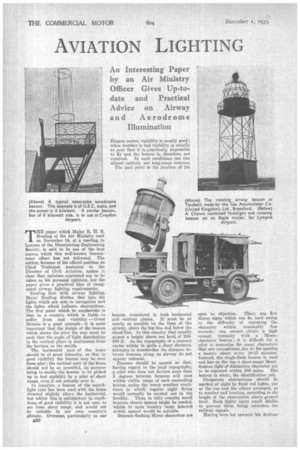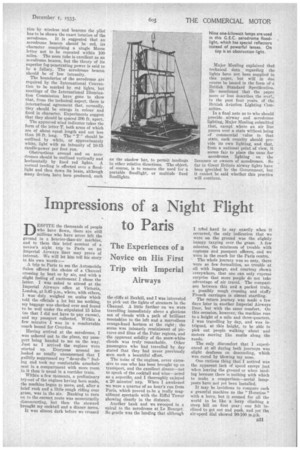AVIATION LIGHTING
Page 48

Page 49

If you've noticed an error in this article please click here to report it so we can fix it.
THE paper which Major B. EL S. blealing of the Air Ministry read on November 14, at a meeting in London of the Illuminating Engineering Society, is said to be one of the best papers which this well-known Government officer has yet delivered. The author, because of his official position as Chief Technical Assistant to the Director of Civil Aviation, makes it clear that opinions expressed are to he taken as his personal opinions, but the paper gives a practical idea of recognized airway lighting requirements.
Dealing first with airway lighting, Major Mealing divides this' into the lights which are aids to navigation and the lights which indicate obstructions. The first point which he emphasizes is that in a country which is liable to suffer from bad visibility—Great Britain is a good example—it is most important that the design of the beacon which shows the pilot the way must be such that the angle of light distribution in the vertical plane is continuous from the horizon to the zenith.
The horizontal part of the beam S4Ionld be of great intensity, so that in good visibility the beacon may be seen from afar; the vertical part of the beam should not be so powerful, its purpose being to enable the beacon to be piaked up in bad visibility by a pilot at short range, even if not actually over it.
In America, a beacon of the searchlight type has been used with the beam directed slightly above the horizontal, but whilst this is satisfactory in conditions of good visibility it is not easy to see from short range, and would not be suitable in our own country's climate. Overseas, particularly on our
330
beacon, considered in both horizontal and vertical planes. It must be as nearly as possible on the lines of the airway, above the fog line and below the cloud line. In this country that usually means a height above sea level. of 200500 ft, As the topography of a country varies widely in quite a short distance, attempts to standardize the distance between beacons along an airway do not appear rational.
Beacons should be spaced so that, having regard to the local topography, R pilot who does not deviate more than 5 degrees between beacons will pass within visible range of each succeeding beacon under the worst weather conditions in which regular night flying would normally be carried out in the locality. Thus, in billy country small beacons closely spaced might be needed, whilst in open country large beacons widely spaced would be suitable.
Beacons flashing Morse characters are open to objection. There are few Morse signs which can be used owing to the difficulty of repeating the character within reasonably few seconds ; one cannot obtain a high enough intensity with a Morse character beacon ; it is difficult for a pilot to memorize the many characters that are necessitated, due to his passing a beacon about every 10-15 minutes. Instead, the single-flash beacon is used and has on the top a short-range identification light of distinctive character not to be repeated within 100 miles. The beacon is white, the identification red.
Dangerous obstructions should be marked at night by fixed red lights, one at the top and the others arranged, as to number and location, according to the height of the obstruction above ground level. Such lights carry small shield to prevent them being mistaken for railway signals.
Having been led towards his deetina tion by wireless and beacons the pilot has to be shown the exact location of the aerodrome. It is suggested that air aerodrome beacon should be red, its character comprising a single Morse letter not to be repeated within 100 miles. The neon tube is excellent as an aerodrome beacon, but the theory of its superior fog-penetrating power is said to be a fallacy. The aerodrome beacon should be of low intensity.
The boundaries of the aerodrome are required by the International Convention to be marked by red lights, but meetings of the International Illumination Commission have gone to show that, from the technical aspect, there is international agreement that, normally, they should be orange in colour and fixed in character. Experiments suggest that they should he spaced 300 ft. apart. The approved wind indicator takes the form of the letter T, both arms of which are of about equal length and not less than 16 ft. long. The " T " should be outlined by white, or approximately white, light with an intensity of 10-15 candle-power per foot run.
Obstructions around and on aerodromes should be outlined vertically and horizontally by fixed red lights. A. normal landing is effected over a floodlight and then down its beam, although many devices have been produced, such as the shadow bar, to permit landings in other relative directions. The object, of course, is to remove the need for a portable floodlight, or multiple fixed floodlights. Major Mealiug explained that technical data regarding the lights have not been supplied in this paper, but will in due course be issued in the form of a British standard Specification. He mentioned that the paper more or less describes the wort., in the past four years, of the British Aviation Lighting Committee.
In a final note as to who should provide airway and aerodrome lighting, Major Mealiug submitted that, except where an air line passes over a state without being of commercial value to that state, each country should provide its own lighting, and that, from a national point of view, it seems fair to place the onus for aerodrome lighting on the licensees or owners of aerodromes. So far in Great Britain airway lights have been tirovided by the Government, but it cannot be said whether this practice will continue.




































































































